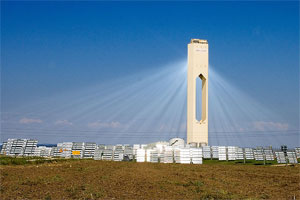 Abengoa's solar power tower, PS10, near Seville, Spain. It is capable of supplying 11 megawatts, or approximately 5,500 households worth of power.Photo: afloresmSouthern California's Antelope Valley is famous for its poppies, luring prospective residents with fiery-orange photographs of the State's most celebrated flower and drawing as many as 60 thousand people each spring to the California Poppy Festival. The region also encompasses the western tip of the sun-scorched Mojave Desert and as a result has recently become the home of one of the most aesthetically striking new designs in alternative energy. On August 5th, the company eSolar flipped the switch on the Sierra Sun Tower, the newest example of what have come to be known as solar "power towers."
Abengoa's solar power tower, PS10, near Seville, Spain. It is capable of supplying 11 megawatts, or approximately 5,500 households worth of power.Photo: afloresmSouthern California's Antelope Valley is famous for its poppies, luring prospective residents with fiery-orange photographs of the State's most celebrated flower and drawing as many as 60 thousand people each spring to the California Poppy Festival. The region also encompasses the western tip of the sun-scorched Mojave Desert and as a result has recently become the home of one of the most aesthetically striking new designs in alternative energy. On August 5th, the company eSolar flipped the switch on the Sierra Sun Tower, the newest example of what have come to be known as solar "power towers."
Comprised of one or two tall narrow towers surrounded by an enormous field of shimmering mirrors beaming sunlight back up from ground level, these power plants work by essentially the same principle you might have exploited as a child in using a magnifying glass and a hot sunny day to burn holes in the leaves of a backyard playground. A magnifying glass focuses sunlight from a round disk into a single bright dot. A solar power tower's field of mirrors focuses light onto a single water tank high in the air. The concentrated light boils the water, and the steam is used to generate electricity.
In other parts of the world the concept of the solar power tower has gained dazzling momentum as well. Last April, the Spanish company Abengoa commenced operation of a new power tower of its own, dubbed PS20. The power output is still a pittance compared to some of the largest fossil fuel or nuclear plants, but at 20 MW it is currently the largest power tower in existence.
The surge of excitement recently in solar power towers may be grounded on more than hype. Other solar technologies tend to be limited in their promise by cost. Caitlin Cieslik-Miskimena, an eSolar press contact, said that many of the components employed in the company are relatively cheap. She noted, for example, that the mirrors used to collect the Sierra Sun Tower's light are "just a step above a bathroom mirror" in quality. Because they are relatively small, they can also be manufactured to be flat, which is considerably less expensive than the parabolic mirrors used in some other designs.
Nevertheless, solar power towers are just one design in a rich assortment of ideas that people have had for harnessing solar energy. Photovoltaic cells are already used ubiquitously to energize calculators, solar-powered cars, and many satellites, and rapid advances continue to be made in this area. A less flashy form of solar thermal power known as SEGS (Solar Energy Generating Systems) uses curved mirrors to heat long troughs of water. The largest solar power plants in the world today are based on this method. Some companies are even proposing that we exploit solar energy by heating air beneath what amounts to a gigantic clear skirt. (Visit this link for a wild virtual tour of one such proposed plant.)
